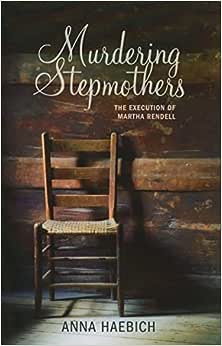
- Free Article: No
- Contents Category: Fiction
- Review Article: Yes
- Article Title: Stepmom stereotype
- Online Only: No
- Custom Highlight Text:
Stepmotherly malevolence is enshrined in myth and legend, and sometimes in real life. Anna Haebich’s Murdering Stepmothers takes up the controversial case of Perth woman Martha Rendell, who in 1909 was tried, convicted and hanged for the murder of her fourteen-year-old stepson. It was widely believed that she also murdered her two stepdaughters in the same fashion, slowly poisoning them by swabbing their throats with hydrochloric acid, invoking the symptoms of an inexplicable illness and a slow, agonising death.
- Book 1 Title: Murdering Stepmothers
- Book 1 Subtitle: The execution of Martha Rendell
- Book 1 Biblio: UWA Publishing, $26.95 pb, 224 pp
- Book 1 Cover Small (400 x 600):

Described by the publisher as a novel, Murdering Stepmothers is one of those texts that self-consciously traverse the history–fiction continuum, weaving historical discourse and archival records into literary imaginings. Haebich’s sources and her inspiration are drawn from a wide spectrum: a multitude of texts and sources are cited as influences, from A.S. Byatt and Margaret Atwood to ‘straight’ histories. This gives her work a diverse and open style. The book opens with the creative reconstruction of events from the perspective of key players in Rendell’s story. Each of these chapters functions as an interior monologue, a kind of intimate testimony addressed to the reader. Haebich also introduces historical context through the characters’ exposition of life in early twentieth-century Perth, and offers a multiplicity of conflicting perspectives about Rendell’s guilt.
We are introduced to the case firstly through the eyes of the tabloid photographer of the lurid publication Truth, whose photographs and articles contributed to the sensationalist frenzy. The second voice is that of the detective in charge of the murder investigation, who concluded that Rendell was indeed a vicious poisoner; his heroes, including Gaboriau’s Lecoq and Sherlock Holmes, unashamedly influence his criminal analysis. This is followed by the more measured, clinical voice of the doctor who follows the trial and whose scepticism about the validity of the medical evidence leads him to posit less salacious explanations for the children’s deaths. Fourthly, the spiritual adviser tending to Martha in her final days, sure of her innocence, laments the callous baying for blood by the self-righteous public.
Vainly seeking answers in the conflicting and hopelessly subjective accounts may prove frustrating for some readers. The final voice marks a distinctive shift in the book, as the modern-day researcher, a thinly veiled Haebich, takes over the narrative. The insertion of the academic voice offers some welcome clarity after the deliberate murkiness of the previous pages; however, while the researcher’s voice might convey some objective authority, lacking in the previous chapters, the scant archival records and subjective rendering of the events of Rendell’s conviction mean that definitive conclusions are elusive. Trial records were not kept, and the researcher is forced to use the secondary source of trial reporting. The lack of accurate forensic evidence; the media’s inflammatory reporting, which condemned Rendell before her trial commenced; the prejudice against a woman who flouted contemporary moral standards: all these factors suggest that the swift condemnation and ongoing assumption of Rendell’s guilt is problematic at best. Tellingly, Haebich chooses not to inhabit the character of Rendell herself, the missing voice reflecting Rendell’s silence in the historical record.
The spectre of Rendell has haunted Haebich for many years, and the level of detail, considered speculation and contextualisation of Rendell’s case is rich and satisfying. Haebich’s sensitivity to the depiction of stepmothers is what drew her to this story. Haebich’s own experience as a stepmother, and her resulting empathy, cause her to reflect on how Rendell faced immediate prejudice by the media, the public and the court. Also considered is the emotional pressure placed on women who follow their lovers to new places where they find themselves alone and caring for sometimes resentful children. In this nuanced and sympathetic imagining of Rendell, the hysterical figure of the fiendish and depraved stepmother is cast against a very ordinary working-class woman struggling with poverty and the desire for respectability.
It is clear that Haebich knows her subject intimately. As with all her work, this is an extremely well-researched piece with an holistic and sensitive approach. Factors that may have predisposed the public and the officials who took part in the case towards vilifying Rendell are addressed: the moral hysteria stirred up by the press; political manoeuvering; and the contemporary concerns about the welfare of working-class children. Beyond scrutinising historical context, Haebich goes further to consider a range of perspectives about stepmotherhood, murderesses, ideals of womanhood and parallels with modern instances, such as the Lindy Chamberlain trial, as she considers the justice behind Rendell’s conviction.
I have always enjoyed the lucidity of Haebich’s writing style and admired her capacity to combine first-rate research with lyricism and an aesthetic sensibility. This is her most creative text to date, perhaps also the most accessible. The shift in form seems to have come relatively easily.


Comments powered by CComment